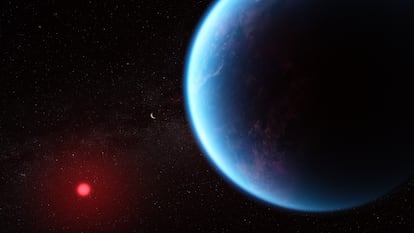Study shows ‘interesting’ signals on an extrasolar planet that are not (yet) alien life
Scientists announce detection of compounds on an extrasolar planet that on Earth only produce living organisms, but other experts urge caution

In more conventional science fiction sagas, extraterrestrials often resemble the living beings we know. Often, they are even intelligent and walk upright on solid planets like our own. However, reality can be stranger. This is the hypothesis being pursued by the team of Cambridge University astronomer Nikku Madhusudhan, who has just announced what he calls “the strongest evidence yet” of life beyond Earth. Other experts, however, believe there is no data to support such a claim.
The new inhabited world would be K2-18b, a Neptune-like planet 120 light-years away, two and a half times the size of Earth, orbiting at a distance from its star that would allow it to have an ocean of liquid water covered by a hydrogen atmosphere. Such worlds, Madhusudhan believes, could be suitable for life. Now, using the James Webb Space Telescope, he has detected two gases on that exoplanet, dimethyl sulfide, or DMS, and dimethyl disulfide, or DMDS, which on Earth are produced mainly by microbial life such as marine phytoplankton (algae) or bacteria.
“This is a revolutionary moment,” Madhusudhan said at the presentation of the discovery, asserting that “it is the first time humanity has seen potential biosignatures on a habitable planet.” While acknowledging that much work is needed to confirm the discovery of extraterrestrial life, the researcher believes the best explanation for his observations is that K2-18b is covered by a temperate, living ocean.
Despite the excitement expressed in his statements, other experts are more cautious. Ignasi Ribas, director of the Institute for Space Studies of Catalonia (IEEC) and research professor at the Spanish National Research Council (CSIC), considers it an “interesting” discovery, but one that falls far short of confirming the discovery of life. “It’s an announcement from a single group, which others will have to try to replicate; it’s a very preliminary stage,” he points out. The results have been published in The Astrophysical Journal Letters, a minor scientific publication. These types of results, according to the sources consulted, do not demonstrate what the expert claims, and although they offer 99.7% certainty, they should have been published in a top-tier journal such as Science or Nature.
As Ribas recalls, this team is leading the research on this exoplanet, with previously controversial results. In 2019, the presence of water was announced, which ultimately turned out to be methane, and in 2023, very weak signals of DMS were published, a signal that has now been observed more intensely. “Then, shortly after the discovery, articles began to be published explaining the presence of the compound in the planet’s atmosphere through mechanisms other than biological activity, and I predict that the same thing will begin to happen in the coming weeks,” Ribas adds.
The James Webb telescope is so powerful that it’s capable of analyzing the chemical composition of a planet’s atmosphere through the light of the star passing through it. Using this technique, the atmospheres of planets similar to K2-18b are already being analyzed in search of more similar signals on similar planets that would allow us to conclude that this isn’t some exotic phenomenon that only occurs in one place. “There are many mini-Neptunes, and that would increase the number of places where we can search for life,” says Ribas.
K2-18b has 8.6 times the mass of Earth and a diameter approximately 2.6 times that of our planet. It orbits in the “habitable zone” — a distance where liquid water, a key ingredient for life, can exist on a planet’s surface — around a red dwarf star smaller and dimmer than our Sun, in the constellation Leo. Another planet has also been identified orbiting this star.
Madhusudhan believes that if these worlds exist, covered by oceans of water and a hydrogen-rich atmosphere, they could support microbial life similar to that observed in Earth’s oceans. Their oceans are hypothesized to be warmer than those on our planet. When asked, during the presentation of this finding, about the possibility of multicellular organisms or even intelligent life, Madhusudhan stated: “We won’t be able to answer this question at this point. The starting hypothesis is simple microbial life.”
The scientist mixed his enthusiasm with caution. “First, we need to repeat the observations two or three times to ensure that the signal we observe is robust and increase the significance of the detection to the point where the odds of a statistical fluke are less than about one in a million,” he stated. “Second, we need further theoretical and experimental studies to determine whether there is another abiotic mechanism (not involving biological processes) that generates DMS or DMDS in a planetary atmosphere like K2-18b’s. While previous studies have suggested them as robust biosignatures even for K2-18b, we must keep an open mind and explore other possibilities,” he concluded. The findings represent a significant uncertainty about whether the observations are due to the presence of life. “No one is interested in prematurely claiming that we have detected life,” the scientist noted.
Other experts urge even more caution. The study finds a “3 sigma” probability of biological activity, which experts say is insufficient: it should at least be 5 sigma. David Clements, an astrophysicist at Imperial College London, told SMC UK: “This is really interesting stuff and, while it does not yet represent a clear detection of dimethyl sulfide and dimethyl disulfide, it is a step in the right direction. To get to a solid claim for the existence of life on this planet we’d need to have a solid detection, >5 sigma, a clear demonstration that this is a biomarker and not some other molecular species masquerading as a biomarker [...] but more and better data will help, and the first step is getting a detection to >5 sigma so that we can be sure that something interesting is there.”
For his part, Stephen Burgess, group leader at the University of Cambridge (but not on Madhusudhan’s team), told the same outlet: “‘Three-sigma’ is a threshold saying that differences observed in the experiment are sufficiently notable that we can exclude the possibility of a chance finding except in rare cases — equivalent in rarity to tossing a coin 10 times and getting the same result each time. ‘Five-sigma’ is a stricter threshold — equivalent to tossing a coin 20 times in a row and getting the same result each time. It’s still possible that we were simply lucky — and the more data that we look at, the greater the chances of making an observation that is purely a chance finding.”
Whatever happens to this mini-Neptune, in the coming years, thanks to machines like James Webb, experts believe there’s a good chance that, if extraterrestrial life exists, its signals will reach Earth and be studied by astronomers. But, remember, we’re not there yet.
Sign up for our weekly newsletter to get more English-language news coverage from EL PAÍS USA Edition
Tu suscripción se está usando en otro dispositivo
¿Quieres añadir otro usuario a tu suscripción?
Si continúas leyendo en este dispositivo, no se podrá leer en el otro.
FlechaTu suscripción se está usando en otro dispositivo y solo puedes acceder a EL PAÍS desde un dispositivo a la vez.
Si quieres compartir tu cuenta, cambia tu suscripción a la modalidad Premium, así podrás añadir otro usuario. Cada uno accederá con su propia cuenta de email, lo que os permitirá personalizar vuestra experiencia en EL PAÍS.
¿Tienes una suscripción de empresa? Accede aquí para contratar más cuentas.
En el caso de no saber quién está usando tu cuenta, te recomendamos cambiar tu contraseña aquí.
Si decides continuar compartiendo tu cuenta, este mensaje se mostrará en tu dispositivo y en el de la otra persona que está usando tu cuenta de forma indefinida, afectando a tu experiencia de lectura. Puedes consultar aquí los términos y condiciones de la suscripción digital.
More information
Archived In
Últimas noticias
NASA discovers Titan doesn’t have an ocean, but a ‘slushy ice layer’ that increases possibility of life
Innocence lost in the forest of the child soldiers: ‘Each leader of the armed group had his girls’
‘Fallout’ or how the world’s largest company turned an anti-capitalist apocalyptic Western into a phenomenon
From inflation to defending migrants: Eileen Higgins and Zohran Mamdani inaugurate the new Democratic resistance against Trump
Most viewed
- ‘El Limones’ and the growing union disguise of Mexican organized crime
- Christian Louboutin: ‘Young people don’t want to be like their parents. And if their parents wear sneakers, they’re going to look for something else’
- The low-cost creative revolution: How technology is making art accessible to everyone
- ‘We are dying’: Cuba sinks into a health crisis amid medicine shortages and misdiagnosis
- A mountaineer, accused of manslaughter for the death of his partner during a climb: He silenced his phone and refused a helicopter rescue











































